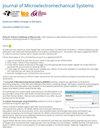模式分离 MEMS 陀螺仪偏差不稳定性噪声的根本原因
IF 2.5
3区 工程技术
Q2 ENGINEERING, ELECTRICAL & ELECTRONIC
引用次数: 0
摘要
本文提出了模式分离 MEMS 陀螺仪的一般不稳定模型。根据应用的角速率和系统参数,所提出的模型可准确预测给定设备的偏置不稳定性。该模型包括两个噪声模型:偏置不稳定性和比例因子不稳定性。其中四个闪烁噪声源是最主要的影响因素。其中包括驱动电容到电压转换器的相位闪变噪声、感应模数转换器 (ADC) 比例因子不稳定性、校准质量电压闪变噪声和加性闪变噪声。我们在四个三轴研究设备上对所有噪声因素进行了全面分析和实验鉴定。根据实验表征的结果,提出的比例因子和偏置不稳定性模型与测量数据进行了验证。我们发现,所提出的模型与测量数据非常吻合。正如提出的模型所预期的那样,驱动电容到电压转换器的相位闪变噪声降低后,偏置不稳定性最多可改善 50%[2024-0018]。本文章由计算机程序翻译,如有差异,请以英文原文为准。
Root-Causes of Bias Instability Noise in Mode-Split MEMS Gyroscopes
This paper presents a general instability model of mode-split MEMS gyroscopes. The proposed model can accurately predict the bias instability of a given device based on the applied angular rate and system parameters. The model consists of two noise models: bias instability and scale factor instability. Four flicker noise sources are considered that are the most significant contributors. These include phase flicker noise of the drive capacitance to voltage converter, sense analog-to-digital (ADC) scale factor instability, proof mass voltage flicker noise, and additive flicker noise. All the noise contributors are thoroughly analyzed and experimentally characterized on four triaxial research devices. Based on the results of the experimental characterization, the proposed scale factor and bias instability models are verified against the measurement data. We find a good match between the presented model and measurements. As anticipated by the proposed model, a reduction of the phase flicker noise of the drive capacitance to voltage converter has led to up to 50% improvement in bias instability.[2024-0018]
求助全文
通过发布文献求助,成功后即可免费获取论文全文。
去求助
来源期刊

Journal of Microelectromechanical Systems
工程技术-工程:电子与电气
CiteScore
6.20
自引率
7.40%
发文量
115
审稿时长
7.5 months
期刊介绍:
The topics of interest include, but are not limited to: devices ranging in size from microns to millimeters, IC-compatible fabrication techniques, other fabrication techniques, measurement of micro phenomena, theoretical results, new materials and designs, micro actuators, micro robots, micro batteries, bearings, wear, reliability, electrical interconnections, micro telemanipulation, and standards appropriate to MEMS. Application examples and application oriented devices in fluidics, optics, bio-medical engineering, etc., are also of central interest.
 求助内容:
求助内容: 应助结果提醒方式:
应助结果提醒方式:


